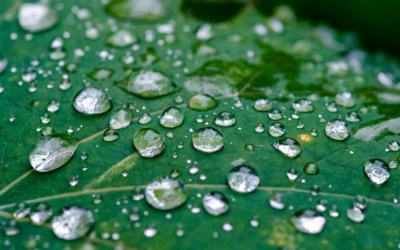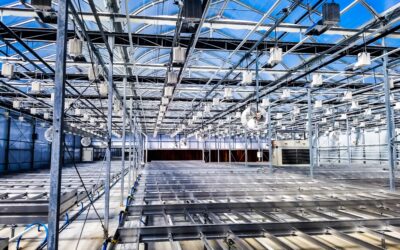In commercial greenhouse design, adhering to the principle of “Begin with the end in mind” is crucial for achieving sustainable success.
Shawn Brown, CEO of LLK Greenhouse Solutions, emphasizes the importance of long-term planning and sustainability in their business approach. By gathering extensive information from clients, LLK ensures their designs meet current needs and allow for future expansion and technological upgrades. This meticulous strategy supports environmental sustainability and economic efficiency, setting a high bar in the industry.
LLK’s proactive approach extends to integrating advanced technologies and methods that boost energy efficiency and operational effectiveness. Recognizing the fluctuations in energy costs and the increasing impacts of climate change on insurance markets, LLK’s designs are built to endure, ensuring long-term viability and resilience.
As the CEA sector drives rapid advancements in technology, LLK remains committed to delivering adaptable, forward-thinking greenhouse solutions. Under Brown’s leadership, LLK prioritizes a balance of cost, efficiency, and environmental responsibility, maintaining their leadership in the greenhouse design-build industry.
Q: “Begin with the end in mind” is a phrase that the LLK team has used to describe greenhouse design. Can you elaborate on why that idea is so important to the work your team does?
A: Sustainability in business means you have to do the right things. You have to have a long-term plan for the long-term success of your customer. That means you’ve really got to start with that end in mind. Through the design process of everything we do, we tend to ask for a lot of information. We’ve actually lost a few jobs because we ask for so much information. The key is that the more information we get, the better solution we can provide to reach that end goal. And it is a long process.
In business, it’s all about the long buck vs. the short buck. You saw this in cannabis. A lot of “consultants/experts” came in, and they were gone fast as they did not provide the desired solution. We’ve been around a long time, so we always try to keep our customers’ best interest in mind by creating the right environment for the crop.
It’s more than just that, though. It’s about creating the right environment for the employees, it’s about material handling, it’s about long-term maintenance and safety.
When you’re designing a greenhouse, how do you service it? How do you maintain it? Sometimes the best design isn’t the safest design, so you really have to prioritize. That’s something that I believe we do a very comprehensive analysis to arrive at.
Q: Can you elaborate on how you incorporate “sustainability,” broadly defined, into your greenhouse solutions, especially in terms of energy efficiency?
A: Interestingly enough, when you go back to the 1970s, when the energy crisis hit, all the greenhouses got really low. They found out that really wasn’t the best environment, because you didn’t get good air stratification. They were opening and closing vents, and it was actually more difficult in the end to regulate temperature. It was less energy-efficient.
I think energy efficiency is more a sign of the economy. It’s a direct relationship to where gas prices are. You saw everyone go to biomass for a while; the boilers became a big deal. I think right now it’s coming back around again. For a couple years there, gas prices were very low. Electric was very low. It’s back on the board again as a hot topic.
Think of the long-term plan again. When we sit down with customers, we go through this and make sure it is part of their business plan. Gas is cheaper, but it’s not always going to be cheap. It cycles. Energy efficiency is always important. It’s a key factor in our design process.
When you go into value engineering (VE), we also design for possible expansion or retrofit. If someone doesn’t have the money or the ability to put in a curtain system, let’s not throw caution to the wind. Let’s make sure that we design it so that it can be easily installed at a later date to help with energy efficiency. We take all of that into consideration.
Q: Can you elaborate on that idea of value engineering?
A: Sales is a funny thing. We have customers who say, “I don’t want to be sold.” But there’s a fine line between selling and educating.
VE is interesting because you want to start with the best. When you start with all the options, you tend to have a high ticket price. People sometimes get nervous. It’s important for us to explain what VE means and how to start the project and even work backward. I’ve never enjoyed going to purchase something and having to get the base model and then somebody coming back and going, “You didn’t ask about this or that.”
We take that approach and come in with our best foot forward to explain what their options are. That means we can sit down and talk about the value engineering process. “What can you give up? What’s the best value proposition you can live with? How do you plan for future pivot in your business?”
Perfect is not doing one thing phenomenally and five other things terribly. Perfection is a funny thing. Perfection, to me, is a balance of good. Perfect, unfortunately, costs a lot of money.
I think about a lot of the institutional jobs we do, where they’re saying that they’re looking at sustainable farming practices and they have redundancy throughout the facility. Most commercial environments can’t afford that. Now, the research is phenomenal, and we find a great balance between our research customers and our commercial customers. Our job as designers is to try to VE that into something that is cost-effective and can provide an ROI whether it is research results or profitability.
Q: How do you work with clients to ensure that the proposed greenhouse solutions provide a solid return on investment?
A: A lot of that boils down to experience. I learned early on about how important it is for customers to spend the time and money for proper design to make sure that a given technology fits their systems. Many times we will come in and use our discovery or value engineering process to say, “Have you thought about this or that?” We’ll talk about new technology that might be available and how it could integrate within their vision or systems. Sometimes it’s great, sometimes it’s, “No way,” and sometimes it’s “Let’s plan for a later phase in.” The institutional market often wants to be the leaders in technology, but not all technology is proven. Someone has to prove it.
There’s a balance: Managing that process of an ROI is really up to the customer giving us the right information. It’s an impossible process if they withhold information, to not tell us exactly what their cycles or turn times or layouts are.
Q: Hurricane season is coming, no doubt. LLK has a unique perspective on that, and certainly on the insurance markets. What should operators bear in mind on that topic?
A: Unfortunately the message right now is not a positive message. The insurance market has been hit extremely hard. Hurricane Ian last year was a big event. There was a lot of catastrophic losses last year for some of the bigger insurance companies. There were some bad tornadoes, some huge hail events. Right now, you’re seeing large wind and hail claims, you’re seeing larger deductibles come out.
I tell people that the best insurance is building a solid structure. Don’t skimp.
With our legacy customers, when we go to do a project, we now say you need to have a stamped structure, and they ask, “What are you talking about? We’ve never had stamped engineered structures.” My personal opinion is, moving forward, the market is going to have to be a little tighter on making sure we’re constructing and manufacturing these structures to meet a higher standard of building code. It flies in the face of what people want to do, build more square footage for less, but I would say that the best insurance is having a quality, solid structure and a good plan for when you do have problems.
Q: How does LLK tailor its greenhouse solutions to different climates and geographical locations to maximize efficiency and yield for its clients?
A: One of the very first things Sylvia Courtney, who leads our design team, does during our discovery phase is a climate study. Before we do anything, we look at three things, especially if it’s a new build and a raw piece of land. Energy availability, water quality and a climate study: Those are the first three things we do before a greenhouse design.
Do we have enough power to operate a facility with potential expansion? That goes back to the long-term planning: Customers want to expand, five acres at a time, and that’s a big expense up front to have the infrastructure to meet that need. You don’t want to expand later on and find out you don’t have enough power.
Geography is critical. There’s a story of a grower who is local to Northeast Ohio. They brought in a grower, a new hire, from out of state, who thought something was wrong with the roof covering. It was low-iron diffused glass. And I pulled up Weather Underground to show that in the last 60 days we had eight days of sun. He was shocked. “Well, I said, this is Northeast Ohio.”
Q: What is your approach to project management for greenhouse construction and upgrades, ensuring that projects are completed on time and within budget?
A: When I started the business, most customers shook their heads and said, “It’s got to be done by this date.” We said, “Okay.” Even when delays arose on a given project, the deadline stood.
On the commercial side, you usually have an established time frame well up front. What’s neat is the institutional market, and working through general contractors for so many projects, we’ve evolved into a project management approach that ensures the successful on time completion of the project. From engaging trades up front on roles and responsibilities and sequencing of installation to the coordination of commissioning and end-user training, our self-performed design-build model is unique in the industry.
It should be noted that weather conditions are taken into consideration when building out a schedule. For example, sometimes end-users or contractors don’t always understand that we shouldn’t be putting glass in and seeding it in butyl at the end of December or January. If you can’t get a roof on, you can’t get heat. That changes the game. Having good schedules is absolutely critical.
Q: Looking ahead, from your perspective as CEO, what emerging trends or technologies have captured your attention?
A: There is so much technology hitting the market. I believe the produce market and the cannabis market drove so much investment so fast. I think it’s poured out into other areas. You had all these companies focused on cannabis, and a lot of them are shifting gears back to commercial. In Canada, for example, they’re renovating cannabis facilities that were formerly vegetable facilities back into vegetable facilities.
Technology-wise, it boils down to material handling. There’s been tremendous growth in environmental controls. I don’t think the greenhouses are changing that much. Water technology, environmental controls, and material handling are the biggest areas of investments being made to address the lack of labor availability. Efficiency is key.
Sign up for the LLK Greenhouse Solutions newsletter below >>>


